|
This airplane is a Lockheed Sirius, s/n 146, manufactured March 13, 1930. It landed once at Tucson Thursday, August 7, 1930 flown by L.B. Andrews. He carried a single passenger identified as "Thorpe." Based in Ft. Worth, TX they were eastbound from Los Angeles, CA to Ft. Worth. I have no information about Andrews or Thorpe. But, given the date, this could be the ferry flight of the airplane to its owner.
NC16W sold first to Stafford L. (Casey) Lambert of St. Louis, MO. He used it for "sports flying". Please follow Lambert's link to see a contemporary photograph of him with his new airplane. Below, from site visitor Stephen Green, are two photographs of NC16W with no markings on the fuselage.
Lockheed Sirius NC16W, Location Unknown, Ca. Early 1930s (Source: Green)
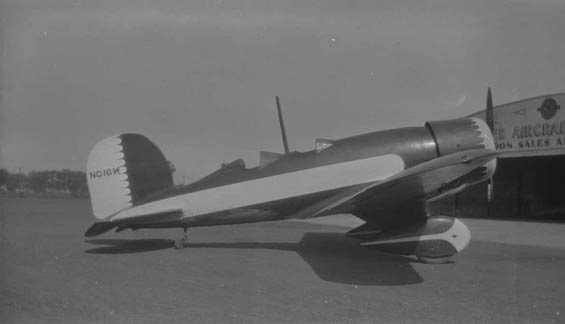 |
Note the radio mast between the cockpits.
Lockheed Sirius NC16W, Location Unknown, Ca. Early 1930s (Source: Green)
 |
These photos were probably taken before the Texas Company livery was painted on the engine cowl and fuselage.
Below, from Tim Kalina (see citation, right sidebar), are images of NC16W dated July 24, 1933 when it was owned by the Texas Company (Texaco). Texaco flew the airplane from 1932 to 1933.
Lockheed Sirius NC16W, July 24, 1933, in Texaco Livery
(Source: Kalina)
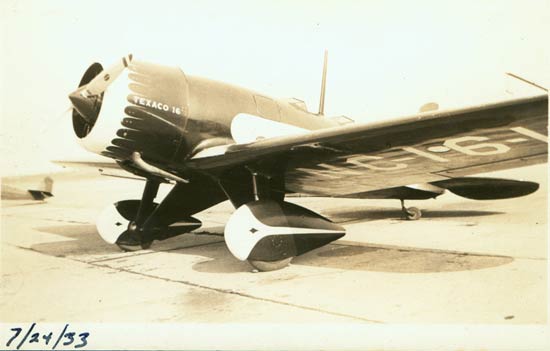 |
In the image below, the engine is being run with the nose cowlings off. You can see a radio antenna mast in both images, just behind the pilot's cockpit. There is a person in the front cockpit, and what appears to be the right leg of another person on the far side of the fuselage, just aft of the right wheel pant.
Lockheed Sirius NC16W, July 24, 1933, in Texaco Livery
(Source: Kalina)
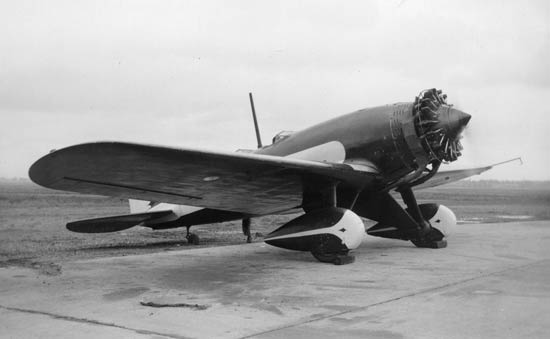 |
The image below, from the port rear quarter is severely washed out in the original. It does show the cockpits and antenna mast to good advantage, though. I "pushed" the empennage with PhotoShop and was unable to pull enough detail out to show the registration number clearly.
Lockheed Sirius NC16W, July 24, 1933, in Texaco Livery
(Source: Kalina)
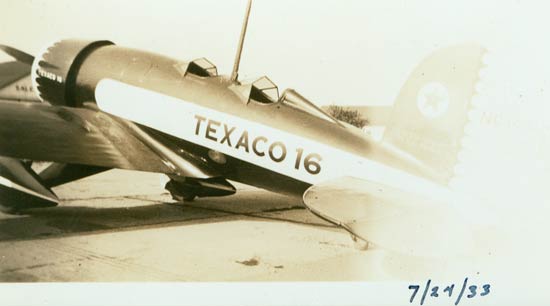 |
Below, clearly showing the airplane's registration number on the rudder.
NC16W, Undated, But Probably Circa 1932-33
(Source: Kalina)
Kalina20081220.jpg) |
From 1933-34 the airplane was flown by Waco Sales, based at Roosevelt Field, LI, NY. It lived in Cleveland, OH from 1934-35, then was transferred to the Cuban Naval Air Force and named "4 de Septiembre". In early 1936 it was flown from Havana to Brazil. Mr. Kalina says about its career with the Cuban Naval Air Force, "NC16W eventually made it’s way into the Cuban Naval Air Force. It was modified with a single cockpit and long range tanks, looking much like an Explorer. It made a flight from Cuba, down into South America, and then across the Atlantic to Africa and ending the flight in Spain. Here’s a Web site with some photos and art [and maps]."
---o0o---
Relevant to its service in Cuba, Mr. Kalina further provides the image of "4 de Septiembre" and its caption below. Compare this photograph to the one near the bottom of the page at the Web link cited above. The gentleman running abreast of the left horizontal stabilizer below is not the same one in the Web link image, suggesting these photos, although of the same aspect of the airplane, were probably taken at different places or at different times.
"4 de Septiembre", February 17, 1936
(Source: Kalina)
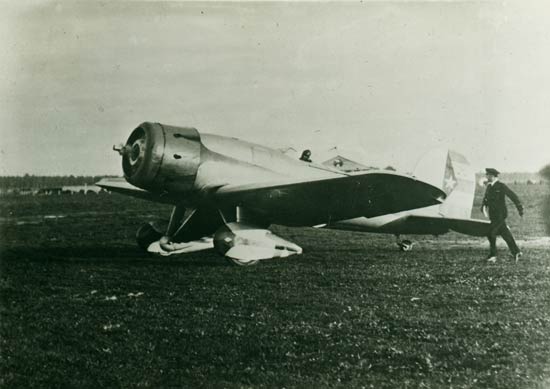 |
He says of the image, The "... date written in ink on the back of the photo, ‘17/02/36’ [February 17, 1936] ... would place the plane somewhere during its record flight from Cuba to South America, Africa, and Spain. Since the photo caption seems to state Seville, I think it may be at the end of the flight in Spain."
Photo Caption, "4 de Septiembre", February 17, 1936
(Source: Kalina)
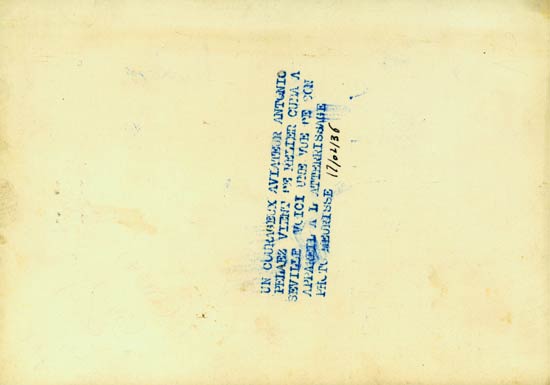 |
This is confirmed by the caption, which, in French, reads, "A courageous aviator, Antonio Pelaez, has just linked Cuba to Seville. Here is a view of his machine after landing. Photo by Meurisse."
---o0o---
According to Allen (REFERENCES), page 225, NC16W was reported destroyed in a hangar fire in Havana sometime in 1945.
---o0o---
Further to NC16W is this photo and caption shared by Mr. Kalina on June 26, 2009. The long-range fuel tank for trans-Atlantic flight is clearly visible between the landing gear struts in this view.
"4 de Septiembre" Dated January 2, 1938
(Source: Kalina)
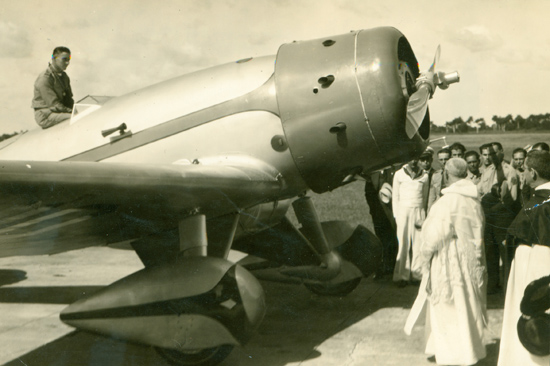 |
Below, the caption on the back of the photo.
"4 de Septiembre" Dated January 2, 1938, Caption
(Source: Kalina)
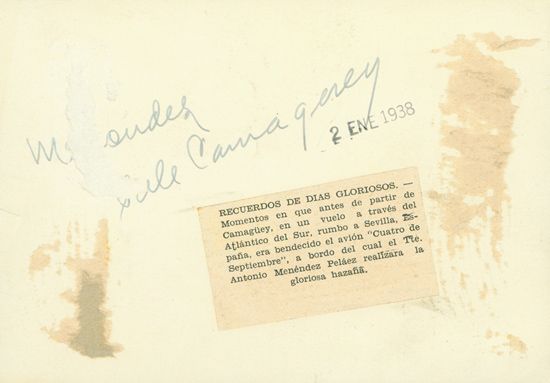 |
The caption is roughly translated as, "Memories of glory days. Moments before departure from Camaguey [Cuba], on a flight across the south Atlantic, heading for Seville, Spain, '4 de Septiembre' was blessed with pilot Antonio Pelaez Menendez undertaking the glorious feat." I'll accept happily better translations from those more fluent in Spanish. A better translation did come to us courtesy of Claudio Luchina, who states, "Here is what I think is a better translation from the back of that photo at the end of that page. The original text had to be adapted a bit not to sound awkward in English:
'MEMORIES OF GLORIOUS DAYS. --
Moments in which -before the departure from Camagüey, on a flight across the South Atlantic, heading to Seville, Spain- the plane "Cuatro de Septiembre" (September the Fourth) was being blessed. On board was the Lieutenant Antonio Menéndez Peláez who completed the glorious feat on that plane.'" Thanks to Claudio.
Below, courtesy of Tim Kalina, is probably the earliest image of NC16W at Floyd Bennett Field. Its livery doesn't match any of the photos above. Notice that it has no wheel pants installed.
Early Photograph of NC16W at Floyd Bennett Field, NY (Source: Web via Kalina)
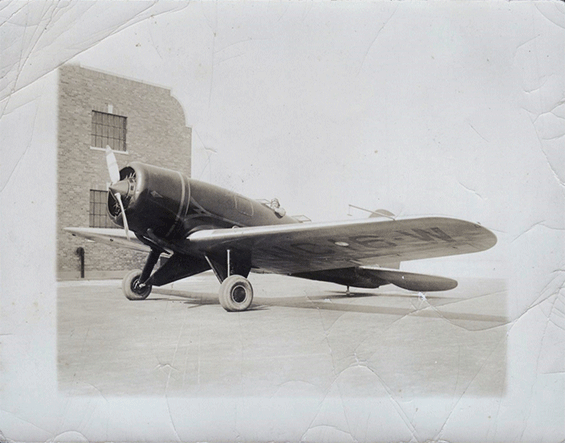 |
UPLOADED: 11/12/08 REVISED: 11/13/08, 06/27/09, 09/14/11, 03/28/16
|

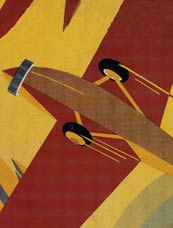





Kalina20081220.jpg)




